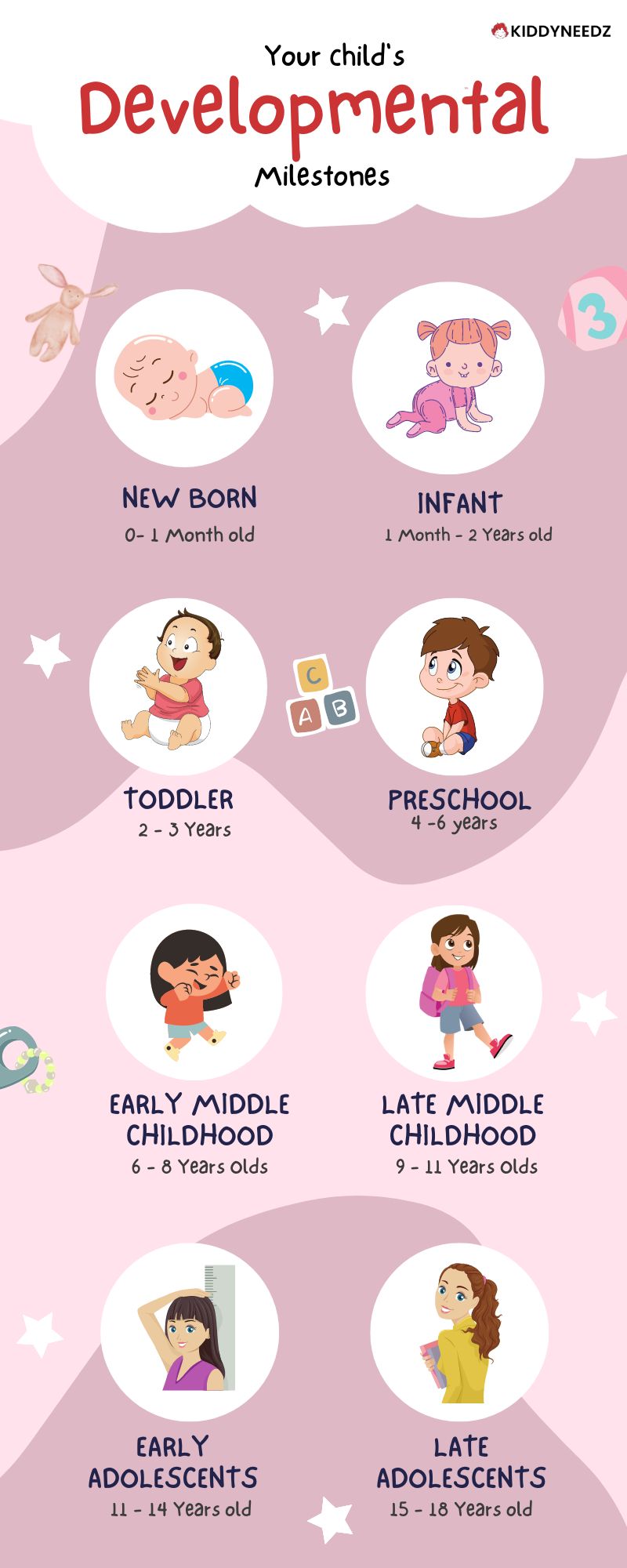Child development is a complex process that involves physical, cognitive, emotional, and social growth.
From birth through adolescence, children progress through a series of childhood development stages, each marked by important milestones and changes in behavior and abilities. These stages are not set in stone, but rather represent general guidelines for what parents, educators, and healthcare professionals can expect to see in typical children.
Understanding the childhood development stages from newborn to adolescence can help adults provide appropriate support and guidance as children grow and develop.
The 8 childhood development stages
Here are some key characteristics and milestones for each of the developmental stages of a child, from newborn to late adolescence. We have also highlighted the key characteristics and milestones for each stage.
Stage 1: Newborn (0 – 1 month)
At this stage, infants are learning to adjust to their new surroundings. They spend most of their time sleeping, eating, and exploring their senses. They may start to focus on faces and voices, and may even attempt to mimic facial expressions.
Newborns are also learning to regulate their body temperature, breathing, and heart rate, which may take some time to fully develop.
Stage 2: Infant (1 month – 2 years)
Infants continue to develop rapidly during this stage. They start to develop gross motor skills, such as rolling over, sitting up, and crawling, and fine motor skills, such as grasping objects and feeding themselves. They also develop language and communication skills, such as babbling, and eventually, forming words and simple sentences.
As infants become more mobile and curious about their surroundings, they also begin to develop a sense of object permanence and start to understand cause-and-effect relationships.
Stage 3: Toddler (2 – 3 years)
Toddlers become more mobile and independent during this stage. They start to walk, run, and climb, and become more curious about the world around them. They may start to express themselves more verbally and develop social skills, such as sharing and playing with others.
In addition to physical and social development, toddlers also experience emotional growth, such as developing self-awareness and empathy for others.
Stage 4: Pre-school (4 – 6 years)
Children in this stage are usually attending preschool and preparing for formal schooling. They continue to develop their language skills and become more interested in reading and writing. They may also develop more complex social skills, such as cooperation and empathy.
At this stage, children’s imagination and creativity flourish as they engage in pretend play and start to understand abstract concepts, such as time and number concepts.
Stage 5: Early Middle Childhood (6 – 8 years)
At this stage, children are typically in elementary school and developing a deeper understanding of academic concepts. They start to develop a stronger sense of self and may become more interested in extracurricular activities, such as sports or music.
In addition to academic and extracurricular pursuits, children in this stage also continue to develop their social skills, such as understanding different perspectives and resolving conflicts with peers.
Stage 6: Late Middle Childhood (9 – 11 years)
Children in this stage are becoming more independent and self-sufficient. They may start to develop more specific interests and hobbies, and become more involved in social groups, such as clubs or sports teams.
As children in this stage become more independent, they may also start to experience more complex emotions, such as anxiety and self-doubt, as they navigate social relationships and academic challenges.
Stage 7: Early Adolescent (11 – 14 years)
Adolescents in this stage are going through significant physical changes as they enter puberty. They may become more interested in romantic relationships and developing their identities. They may also experience some emotional ups and downs as they navigate these changes.
In addition to physical and emotional changes, early adolescents also experience cognitive development, such as developing critical thinking skills and questioning authority and societal norms.
Stage 8: Late Adolescent (15 – 18 years)
Adolescents in this stage are preparing for adulthood and becoming more independent. They may be thinking about college or career goals and developing a stronger sense of their own values and beliefs. They may also become more interested in social and political issues and start to develop a deeper understanding of the world around them.
At this stage, adolescents may also start to experience more mature emotional relationships, such as intimate relationships, and may start to understand the long-term consequences of their decisions.
Please note
These childhood development stages are not set in stone, and individual children may develop at different rates and in different ways. Additionally, cultural and environmental factors can also influence a child’s development.
Therefore, while these childhood development stages provide a useful framework for understanding a child’s growth and development, it’s important for parents, caregivers, and educators to approach each child as an individual with unique needs and experiences.
By understanding and supporting a child’s development in a holistic way, we can help them reach their full potential and thrive as they navigate the different stages of childhood and adolescence.
